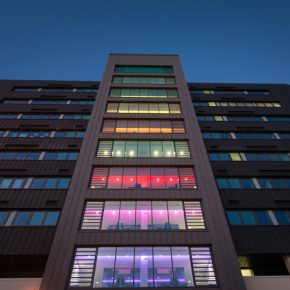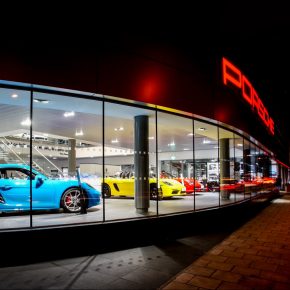
Why building envelopes can lower energy usage and secure our future – SFS
Exploring how the building envelope can support the reduction in energy usage and enhance a building’s lifespan can help the construction industry achieve zero-carbon buildings. Vincent Matthews, Head of UK Marketing at SFS, talks here about what considerations contractors should be prioritising.
“Today’s critical challenge in construction is to ensure we keep the momentum around the transformation of buildings whilst reducing energy usage.
The IEA’s Reference Technology Scenario (RTS), stated that final energy demand in the global buildings sector will increase 30% by 2060 if more ambitious effort is not made to address low-carbon and energy-efficient solutions for buildings and construction [1].
Contractors and installers particularly must be wise to how they can help, given that they are often at the forefront of project planning, construction, and materials and component selection.
Lowering carbon emissions starts from construction through to when the building is in use, and even in maximising the lifespan of the building itself.
With good planning and preparation, along with the right mix of components, energy consumption and carbon footprint can be minimised within building envelopes.
The building envelope in detail
Responsible for moisture control, temperature control, and air boundaries, the building envelope can make a huge difference to the energy efficiency of a building – reducing energy lost and protecting the indoor environment.
Put simply, a building envelope is the exterior of a building which repels the elements – the roof, subfloor, exterior walls, exterior doors and windows.
Although simple in principle, the building envelope is a complex piece of engineering, with different elements that must work together to ensure the integrity of the building.
The roof of a building is one of its main energy efficiency blackspots, accounting for 25-30% of all heat lost through the envelope. To maximise the thermal qualities and reduce energy loss from any roof, it is vital that there is no break in the insulation which can compromise its integrity.
Known as thermal bridges, these weak spots are commonly caused by breaks in the insulation, protruding joists, wall ties and bad workmanship.
One weak spot often overlooked is the fasteners themselves. A typical roof installation uses thousands of fasteners, each one a potential thermal bridge.
Flat roofing solutions such as the isotak® thermally broken sleeve and fastener from SFS will ensure that cladding is properly secured, avoiding thermal bridges and decreasing energy loss.
The two-part fastener sits inside a sleeve which penetrates below the surface of the insulation, providing a barrier between the fastener head and the external atmospheric conditions.
The stainless-steel construction of the fastener conducts heat at a slower pace than carbon steel, further improving the thermal efficiency of the envelope as well as offering the improved corrosion-resistance required to ensure a longer lifespan.
Rainscreen Cladding – choosing the right system
Rainscreen systems are typically designed to meet mechanical and thermal needs – using components from a range of suppliers to create a full system. The façade of a building also represents a key blackspot for energy efficiency.
Rainscreen cladding is one way to keep the rain out, while also offering an inner layer of thermal insulation, preventing excessive air leakage and protecting against wind.
However, as with any part of the building envelope, the correct specification and fitting of these layered cladding systems is vital. Sourcing different components from different suppliers, the system may not necessarily be as energy efficient as it can be.
SFS’ NVELOPE® Project Builder overcomes this challenge. This unique specification tool can identify a bespoke solution, pairing the right fixings with the right brackets and subframe systems to create a solution which best fits the thermal requirements of the project.
The Centre for Virus Research is a case in point. Using Project Builder and the NVELOPE® support system from SFS helped to provide the research centre with an aesthetically pleasing and state-of-the-art facility, which since completion, has achieved BREEAM Excellent status.
The Project Builder software was used to provide wind load calculations and pricing, eliminating any surprises on-site. To check the workmanship and design performance of this project, the Centre for Window and Cladding Technology (CWCT) oversaw a rigorous test of the cladding against dynamic loads and weather resistance.
The test achieved the highest possible scores, which in turn proved the efficiency of the products used.
Minimising project downtime
As with everything in life, technology evolves, bringing with it new efficiencies which older technology simply can’t offer. For those participating in the construction and design of a building, embracing this new technology is key.
Opting for a known solution seems an easy way to estimate project timelines but is not always the answer to building quicker and building more efficiently.
Newer generations of fasteners, fixtures and brackets are being developed to aid a quick and easy installation. Two instances of cleverly engineered fastening components are the SXC5 and the TDBL from SFS.
The former is a self-drilling composite fastener that has been re-engineered to have an optimised tip and thread geometry.
This allows installers to drive the SXC5 into the material they are securing to quicker – saving valuable time and money. Similarly, the self-threading TDBL also enables faster installations.
Ideal for awkward areas such as box sections and ‘blind’ fixings, the TBDL can be inserted into punched holes to fix thin to thick metal structures together, vastly reducing fixing time.
Minimising reworks is also vital to cost control, as well as wider carbon consumption. In a bid to make buildings secure, fixings can be subjected to ‘overdriving’.
This causes damage to the substrate, as well as the fixing itself, sometimes requiring layers to be replaced before the job can progress.
Using fasteners such as the SDK by SFS – which is designed with a square drive which will snap-off when the ideal torque is reached – can massively reduce the risk of compromising the structure.
It is this hidden detail and innovation that can go some way to reducing additional carbon spend. By getting it right first time, there is less chance of needing to revisit sites, and less energy needed to manufacture more materials to replace incorrectly installed components.
The refurbishment of Parsons Building at Newcastle College is where this pre-planned forward thinking took centre stage. With a chosen aesthetic of zinc and copper cladding, the project required low profile, high-grade stainless-steel fasteners to fix the cladding to various composite panels.
The solution was the SX2/8-D9 self-drilling fastener, providing excellent pull out values and reduces over-driving due to the thread design. The building also featured the isotak® TIA adjustable fastener system, reducing fastener and polypropylene sleeve combinations by 50% and significantly reducing drilling times.
Teamwork is dreamwork
Component manufacturers have a key role to play here in educating the marketplace on the latest technology. As suppliers and installers strive to meet stringent building regulations and improve energy efficiency, they must work together to ensure a successful construction of the building envelope.
Through collaboration, the right specification of materials, optimised project planning and minimised works, we can arrest the energy consumption of the built environment, and by token, secure the future of our world.”
Source
[1] https://www.worldgbc.org/sites/default/files/UNEP%20188_GABC_en%20%28web%29.pdf
Contact
SFS Group Fastening Technology Ltd
153 Kirkstall Road
Leeds
LS4 2AT
Phone number : +44 (0)330 0555 888
Email : ukenquiries@sfs.com
Visit Supplier's page
Latest news

26th March 2025
BMBI: Builders’ Merchants value sales down -2.3% in January year-on-year, with flat volume sales and prices down -2.3%
The latest Builders Merchant Building Index (BMBI) report shows builders’ merchants value sales in January were down -2.3% compared to the same month in 2024. Volume sales were flat (+0.0%) and prices slipped -2.3%. There was no difference in trading days.
Posted in Architectural Ironmongery, Articles, Bathrooms & Toilets, Bathrooms, Bedrooms & Washrooms, Bricks & Blocks, Building Associations & Institutes, Building Industry News, Building Products & Structures, Building Services, Building Systems, Civil Engineering, Concrete, Cement, Admixtures, Doors, Drainage, Drainage Services, Drainage, Guttering, Soffits & Fascias, Facility Management & Building Services, Fascias, Hand Tools, Hard Landscaping & Walkways, Heating Systems, Controls and Management, Heating, Ventilation and Air Conditioning - HVAC, Information Technology, Interior Design & Construction, Interiors, Kitchens, Landscaping, news, Pipes, Pipes & Fittings, Plant, Equipment and Hire, Plumbing, Posts, Power Tools, Publications, Research & Materials Testing, Retrofit & Renovation, Timber Buildings and Timber Products, Walls, Windows
26th March 2025
Encasement Verta column casings - covering up with style
The demands of architects and specifiers seeking to create stylish finishes on a diverse range of building interior and exterior projects are the main drivers behind the versatility and extensive choice available within the Encasement Verta column casing range.
Posted in Articles, Building Industry News, Building Products & Structures, Canopies, Entrances & Column Casings, Case Studies, Interior Design & Construction, Interiors, Restoration & Refurbishment, Retrofit & Renovation, Walls
26th March 2025
Pyroguard launches on-demand CPD webinar
Pyroguard has launched an on-demand version of its RIBA-approved CPD seminar – ‘Fire safety glazing: a system, not a product’ – in a bid to guide the industry regarding the critical role of fire safety glass.
Posted in Articles, Building Industry Events, Building Industry News, Building Products & Structures, Building Services, Continuing Professional Development (CPD's), Glass, Glazing, Health & Safety, Information Technology, Innovations & New Products, Posts, Retrofit & Renovation, Seminars, Training, Windows
25th March 2025
Reduce sound transference with West Fraser CaberAcoustic
CaberAcoustic from West Fraser is a highly versatile, effective and economical sound-reducing flooring solution. Reducing both impact and airborne transmitted sounds, it can be laid over concrete and timber floors in both new and existing buildings.
Posted in Acoustics, Noise & Vibration Control, Articles, Building Industry News, Building Products & Structures, Building Services, Building Systems, Facility Management & Building Services, Floors, Interior Design & Construction, Interiors, Posts, Restoration & Refurbishment, Retrofit & Renovation, Timber Buildings and Timber Products
 Sign up:
Sign up: